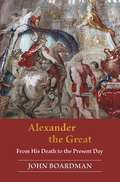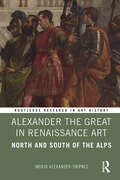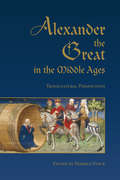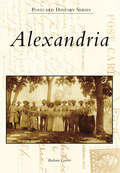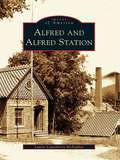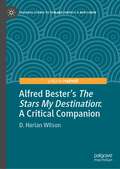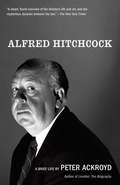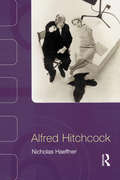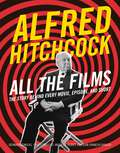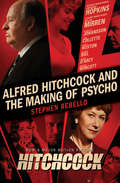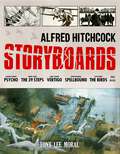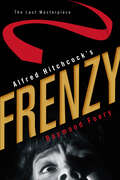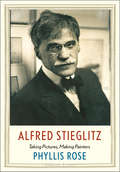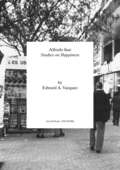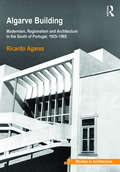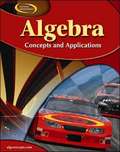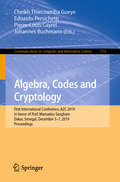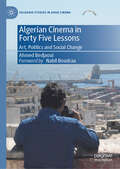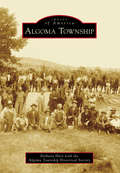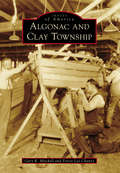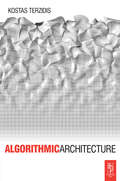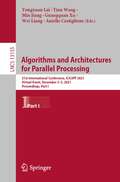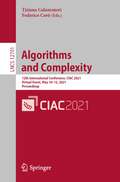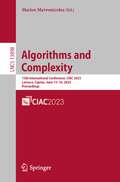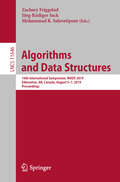- Table View
- List View
Alexander the Great: From His Death to the Present Day
by John BoardmanAn illustrious scholar presents an elegant, concise, and generously illustrated exploration of Alexander the Great’s representations in art and literature through the agesJohn Boardman is one of the world’s leading authorities on ancient Greece, and his acclaimed books command a broad readership. In this book, he looks beyond the life of Alexander the Great in order to examine the astonishing range of Alexanders created by generations of authors, historians, and artists throughout the world—from Scotland to China.Alexander’s defeat of the Persian Empire in 331 BC captured the popular imagination, inspiring an endless series of stories and representations that emerged shortly after his death and continues today. An art historian and archaeologist, Boardman draws on his deep knowledge of Alexander and the ancient world to reflect on the most interesting and emblematic depictions of this towering historical figure.Some of the stories in this book relate to historical events associated with Alexander’s military career and some to the fantasy that has been woven around him, and Boardman relates each with his customary verve and erudition. From Alexander’s biographers in ancient Greece to the illustrated Alexander “Romances” of the Middle Ages to operas, films, and even modern cartoons, this generously illustrated volume takes readers on a fascinating cultural journey as it delivers a perfect pairing of subject and author.
Alexander the Great in Renaissance Art: North and South of the Alps (Routledge Research in Art History)
by Ingrid Alexander-SkipnesThis volume explores the images of Alexander the Great from the fifteenth and sixteenth centuries, how they came about, and why they were so popular.In contrast to the numerous studies on the historical and legendary figure of Alexander, surprisingly few studies have examined, in one volume, the visual representation of the Macedonian king in frescoes, oil paintings, engravings, manuscripts, medals, sculpture, and tapestries during the Renaissance. The book covers a broad geographical area and includes transalpine perspectives. Ingrid Alexander-Skipnes examines the role that humanists played in disseminating the stories about Alexander and explores why Alexander was so popular during the Renaissance. Alexander-Skipnes offers cultural, political, and social perspectives on the Macedonian king and shows how Renaissance artists and patrons viewed Alexander the Great.The book will be of interest to scholars working in art history, Renaissance studies, ancient Greek history, and classics.
Alexander the Great in the Middle Ages
by Markus StockIn the Middle Ages, the life story of Alexander the Great was a well-traveled tale. Known in numerous versions, many of them derived from the ancient Greek Alexander Romance, it was told and re-told throughout Europe, India, the Middle East, and Central Asia. The essays collected in Alexander the Great in the Middle Ages examine these remarkable legends not merely as stories of conquest and discovery, but also as representations of otherness, migration, translation, cosmopolitanism, and diaspora.Alongside studies of the Alexander legend in medieval and early modern Latin, English, French, German, and Persian, Alexander the Great in the Middle Ages breaks new ground by examining rarer topics such as Hebrew Alexander romances, Coptic and Arabic Alexander materials, and early modern Malay versions of the Alexander legend. Brought together in this wide-ranging collection, these essays testify to the enduring fascination and transcultural adaptability of medieval stories about the extraordinary Macedonian leader.
Alexandria (Postcard History Series)
by Barbara GroverAlexandria is situated near the center of Douglas County, surrounded by a chain of beautiful lakes. These lakes brought pioneer settlers to the area as early as 1858, when Minnesota achieved statehood and the town was established. The lakes remain a key factor that continue to draw residents and visitors. The images in Postcard History Series: Alexandria tell the community's story, recalling fond memories of the businesses, churches, homes, schools, and recreational opportunities that form the generous and caring nature of the welcoming community that is Alexandria.
Alfred and Alfred Station
by Laurie Lounsberry McfaddenAlfred and Alfred Station reveals the heritage of a southwestern New York State community nestled in the hills of Allegany County. With more than 200 pictures, the story honors the early pioneers who in 1807 permanently settled on forested land once inhabited by the Seneca Nation. It focuses on not only education--always highly valued, as evidenced in the three institutions of higher learning here--but also on the people, businesses, farms, and civic organizations that have enriched the town for 200 years.
Alfred Bester’s The Stars My Destination: A Critical Companion (Palgrave Science Fiction and Fantasy: A New Canon)
by D. Harlan WilsonIn this comprehensive study of The Stars My Destination, D. Harlan Wilson makes a case for the continued significance of Alfred Bester’s SF masterwork, exploring its distinctive style, influences, intertextuality, affect, and innovation as well as its extensive metafictional properties. In Stars, Bester established himself as a son of the pulp-SF and high-modernist writers that preceded him and a forefather to the New Wave and cyberpunk movements that followed his lead. Wilson’s study depicts Bester as an SF insider as much as an outlier, writing in the spirit of the genre but breaking with the fixation on hard science in favor of psychological interiority, literary experimentation, and adult themes. The book combines close-readings of the novel with broader concerns about contemporary media, technoculture, and the current state of SF itself. In Wilson’s view, SF is a moribund artform, and Stars foresaw the inevitable science fictionalization of our benighted world. With scholarly lucidity and precision, Wilson shows us that Stars pointed the way to what we have (un)become.
Alfred Hitchcock
by Peter AckroydA gripping short biography of the extraordinary Alfred Hitchock, the master of suspense. Alfred Hitchcock was a strange child. Fat, lonely, burning with fear and ambition, his childhood was an isolated one, scented with fish from his father's shop. Afraid to leave his bedroom, he would plan great voyages, using railway timetables to plot an exact imaginary route across Europe. So how did this fearful figure become the one of the most respected film directors of the twentieth century? As an adult, Hitch rigorously controlled the press's portrait of him, drawing certain carefully selected childhood anecdotes into full focus and blurring all others out. In this quick-witted portrait, Ackroyd reveals something more: a lugubriously jolly man fond of practical jokes, who smashes a once-used tea cup every morning to remind himself of the frailty of life. Iconic film stars make cameo appearances, just as Hitch did in his own films: Grace Kelly, Cary Grant, and James Stewart despair of his detached directing style and, perhaps most famously of all, Tippi Hedren endures cuts and bruises from a real-life fearsome flock of birds. Alfred Hitchcock wrests the director's chair back from the master of control and discovers what lurks just out of sight, in the corner of the shot.
Alfred Hitchcock
by Nicholas HaeffnerNicholas Haeffner provides a comprehensive introduction to Alfred Hitchcock's major British and Hollywood films and usefully navigates the reader through a wealth of critical commentaries. One of the acknowledged giants of film, Hitchcock's prolific half-century career spanned the silent and sound eras and resulted in 53 films of which Rear Window (1954), Vertigo (1958) and Psycho (1960) are now seen as classics within the suspense, melodrama and horror genres. In contrast to previous works, which have attempted to get inside Hitchcock's mind and psychoanalyse his films, this book takes a more materialist stance. As Haeffner makes clear, Hitchcock was simultaneously a professional film maker working as part of a team in the film factories of Hollywood, a media celebrity, and an aspiring artist gifted with considerable entrepreneurial flair for marketing himself and his films. The book makes a case for locating the director's remarkable body of work within traditions of highbrow, middlebrow and lowbrow culture, appealing to different audience constituencies in a calculated strategy. The book upholds the case for taking Hitchcock's work seriously and challenges his popular reputation as a misogynist through detailed analyses of his most controversial films.
Alfred Hitchcock All the Films: The Story Behind Every Movie, Episode, and Short
by Bernard Benoliel Gilles Esposito Murielle Joudet Jean-François RaugerOrganized chronologically and covering every short film, television episode, and classic film that the "Master of Suspense" directed over the course of his illustrious, 60-year career, Alfred Hitchcock All the Films draws upon years of research to tell the behind the scenes stories of how each project was conceived, cast, and produced, down to the creation of the costumes, the search for perfect locations, and of course, the direction of some of cinema's most memorable scenes. Spanning more than six decades, and including stories of work with longtime collaborators like costume designer Edith Head, title designer Saul Bass, and composer Bernard Herrmann, this book details the creative processes that resulted in numerous classic films like Vertigo,The Birds,Psycho, Rear Window, North By Northwest,andTo Catch a Thief (to name a few). The director's classic TV series are also covered extensively along with original release dates, lesser-known short films, box office totals, surreptitious casting details, and other insider scoops that will keep fans and students alike turning pages. Alfred Hitchcock All the Films is the perfect book for the movie fan in your life.
Alfred Hitchcock and the Making of Psycho
by Stephen RebelloA &“meticulous history&” of the classic suspense film based on exclusive interviews with the director, writers, cast, and crew (The New York Times Book Review).First released in June 1960, Psycho altered the landscape of horror films forever. But just as compelling as the movie itself is the story behind it, which has been adapted as a movie starring Anthony Hopkins as Hitchcock, Helen Mirren as his wife Alma Reville, and Scarlett Johansson as Janet Leigh. Stephen Rebello brings to life the creation of one of Hollywood&’s most iconic films, from the story of Wisconsin murderer Ed Gein, the real-life inspiration for the character of Norman Bates, to Hitchcock&’s groundbreaking achievements in cinematography, sound, editing, and promotion. Packed with captivating insights from the film&’s stars, writers, and crewmembers, Alfred Hitchcock and the Making of Psycho is a riveting and definitive history of a signature Hitchcock cinematic masterpiece.
Alfred Hitchcock Storyboards
by Tony Lee MoralA one-of-a-kind historical document and celebration of the artwork behind several of the Master of Suspense&’s greatest films.This stunning coffee table book focuses on the storyboards for nine of Alfred Hitchcock&’s classic movies – Vertigo, The Birds, Psycho, North by Northwest, The 39 Steps, Torn Curtain, Marnie, Shadow of a Doubt and Spellbound. It includes never before-published images and incisive text putting the material in context and examining the role the pieces played in some of the most unforgettable scenes in cinema. Hitchcock author and aficionado Tony Lee Moral provides a fascinating and illuminating insight into the directorial mind of the Master of Suspense.
Alfred Hitchcock's Frenzy: The Last Masterpiece
by Raymond FoeryAfter an unparalleled string of artistic and commercial triumphs in the 1950s and 1960s, Alfred Hitchcock hit a career lull with the disappointing Torn Curtain and the disastrous Topaz. In 1971, the depressed director traveled to London, the city he had left in 1939 to make his reputation in Hollywood. The film he came to shoot there would mark a return to the style for which he had become known and would restore him to international acclaim. Like The 39 Steps, Saboteur, and North by Northwest before, Frenzy repeated the classic Hitchcock trope of a man on the run from the police while chasing down the real criminal. But unlike those previous works, Frenzy also featured some elements that were new to the master of suspense’s films, including explicit nudity, depraved behavior, and a brutal act that would challenge Psycho’s shower scene for the most disturbing depiction of violence in a Hitchcock film. In Alfred Hitchcock’s Frenzy: The Last Masterpiece, Raymond Foery recounts the history—writing, preprod
Alfred Stieglitz: Taking Pictures, Making Painters (Jewish Lives)
by Phyllis RoseA fascinating biography of a revolutionary American artist ripe for rediscovery as a photographer and champion of other artists Alfred Stieglitz (1864–1946) was an enormously influential artist and nurturer of artists even though his accomplishments are often overshadowed by his role as Georgia O’Keeffe’s husband. This new book from celebrated biographer Phyllis Rose reconsiders Stieglitz as a revolutionary force in the history of American art. Born in New Jersey, Stieglitz at age eighteen went to study in Germany, where his father, a wool merchant and painter, insisted he would get a proper education. After returning to America, he became one of the first American photographers to achieve international fame. By the time he was sixty, he gave up photography and devoted himself to selling and promoting art. His first gallery, 291, was the first American gallery to show works by Picasso, Rodin, Matisse, and other great European modernists. His galleries were not dealerships so much as open universities, where he introduced European modern art to Americans and nurtured an appreciation of American art among American artists.
Alfredo Jaar: Studies on Happiness (Afterall Books / One Work)
by Edward A. VazquezA richly illustrated survey of Alfredo Jaar&’s Studies on Happiness (1979–1981) and its deep political stakes in the historical context of Chile&’s neoliberal transition.Between 1979 and 1981, Alfredo Jaar asked Chileans a deceptively simple question: "Are you happy?" Through private interviews, sidewalk polls and video-recorded forums, among other interventions, Jaar&’s three-year and seven-phase project, Studies on Happiness, addressed a furtive and fearful population living under Augusto Pinochet&’s military dictatorship. It also spoke to a country in transition, as a newly adopted constitution remade Chile through privatisation and other neoliberal reforms. In its varied interventions and direct mode of address, Studies on Happiness functioned as a feedback device meant to catalyse a critical awareness with its blunt questioning.Edward A. Vazquez contextualises Studies on Happiness within Jaar&’s early production and situates his practice within a Chilean art world haunted by the residues of political violence. This study foregrounds the project&’s historical embeddedness and the deep political stakes of its apparent sociality, recognising the crucial role that context has always played in Jaar&’s practice. By turning to the Santiago of Studies on Happiness, Vazquez explores the work&’s political and art historical environment and provides a wedge to realign current interpretations of Chilean art and hemispheric conceptualism with the openness central to Jaar&’s project.
Algarve Building: Modernism, Regionalism and Architecture in the South of Portugal, 1925-1965
by Ricardo AgarezForeword by Adrian Forty. The Algarve is not only Portugal’s foremost tourism region. Uniquely Mediterranean in an Atlantic country, its building customs have long been markers of historical and cultural specificity, attracting both picturesque driven conservatives and modernists seeking their lineage. Modernism, regionalism and the ‘vernacular’ – three essential tropes of twentieth-century architecture culture – converged in the region’s building identity construct and, often the subject of strictly metropolitan elaborations, they are examined here from a peripheral standpoint instead. Drawing on work that won the Royal Institute of British Architects President’s Award for Outstanding PhD Thesis in 2013, Algarve Building challenges the conventional inclusion of Portuguese modern architecture in ‘Critical Regionalism’ narratives. A fine-grain reconstruction of the debates and cultures at play locally exposes the extra-architectural and widely participated antecedents of the much-celebrated mid-century shift towards the regional. Uncelebrated architects and a cast of other players (clients, officials, engineers and builders) contributed to maturing a regional strand of modern architecture that, more than being the heroic outcome of a hard-fought ‘battle’ by engaged designers against a conservative establishment, became truly popular in the Algarve. Algarve Building shows, more broadly, what the processes that have been appropriated by the canon of architectural history and theory – such as the presence of folk traditions and regional variation in learned architecture – stand to gain when observed in local everyday practices. The grand narratives and petites histoires of architecture can be enriched, questioned, revised and confirmed by an unprejudiced return to its facts and sources – the buildings, the documents, the discourses, the agents and the archives.
Algebra: Concepts and Applications
by Glencoe McGraw-Hill StaffAn ideal program for struggling students Glencoe Algebra: Concepts and Applications covers all the Algebra 1 concepts. This program is designed for students who are challenged by high school mathematics.
Algebra, Codes and Cryptology: First International Conference, A2C 2019 in honor of Prof. Mamadou Sanghare, Dakar, Senegal, December 5–7, 2019, Proceedings (Communications in Computer and Information Science #1133)
by Johannes Buchmann Edoardo Persichetti Cheikh Thiecoumba Gueye Pierre-Louis CayrelThis book presents refereed proceedings of the First International Conference on Algebra, Codes and Cryptology, A2C 2019, held in Dakar, Senegal, in December 2019.The 14 full papers were carefully reviewed and selected from 35 submissions. The papers are organized in topical sections on non-associative and non-commutative algebra; code, cryptology and information security.
Algerian Cinema in Forty Five Lessons: Art, Politics and Social Change (Palgrave Studies in Arab Cinema)
by Ahmed BedjaouiAlgerian Cinema in Forty Five Lessons offers a fresh approach to examine the history of Algerian cinema, from its inception to the present day, providing in-depth analysis of forty five key films. While most scholarly and critical work on Algerian cinema continues to centre on the War of Independence and those films engaging with it, Dr Ahmed Bedjaoui argues that this thematic dominance has overshadowed many other important aspects of Algerian film history. Further, Bedjaoui examines how "revolutionary" films have frequently depicted an idealized image of a heroic, flawless and fearless figure which has been strategically crafted to legitimize national authority at different points in time. This book offers a new reading, which involves rehabilitating some major but underestimated works, as well as questioning other films primarily known for their contribution to the Algerian national story. Among the works studied, certain productions offer a less Manichean vision of the War of Independence, while explaining the process that led to it. Above all, Bedjaoui strives to bring out of the shadows films of great artistic value (sometimes produced by state television), and compares the productions of the so-called golden age (1960s and 1970s) with the films made by the following generations, in terms of both creativity and capacity to reflect the specificity of Algerian society. Through a contextualization of forty specific films, this book provides a deep analysis of the changes which occurred in the heart of Algerian society, moving from an all-socialist to an all-protectionist state, before being later threatened by religious fundamentalism. Engaging and accessibly written, and including coverage of many films never written about in English-language histories of Algerian cinema, this book is an essential resource for understanding this dynamic and vital film culture.
Algoma Township
by Algoma Township Historical Society Bethany HartAlgoma Township was established by the Michigan Legislature on March 15, 1849, and named in honor of the steamer Algoma, which ran a route on the nearby Grand River in 1848. The township's earliest settlers included the Lapham, Davis, Helsel, Morningstar, and Porter families, among others. Early residents logged and farmed the area's land; today, these traditions continue. The Powell and Bowler farms are just two local examples of Centennial Farms (farms that have been owned and operated by the same family for more than 100 years). Other groups--including the Algoma Grange No. 751, United Brethren Church, and small rural schools--helped to establish a community in Algoma even without it having an independent town center. As a result, Algoma grew beyond its humble beginnings and Native American name that translates to "fields of wild roses." The treasured stories and images presented in this collection aim to highlight Algoma Township's development and the hardworking people who call the township home.
Algonac and Clay Township (Images of America)
by Gary R. Mitchell Forest Lee ChaneyAs early as 1615, Frenchmen settled along the St. Clair River in the area now known as Algonac and Clay Township to trade furs with Native Americans. Despite Louis XIV's determination to build a colonial empire in this region, the French "fleur-de-lis" was replaced by the British Union Jack in 1760 and then by the American "Stars and Stripes" in 1783, making it one of the few regions in Michigan to have flown the flags of three nations. Following the decline of the fur trade, three major industries--lumber, boatbuilding, and salt production--provided pioneers with the means to amass fortunes. By the 19th century, Algonac and Clay Township had produced 47 sailboats and 26 steamboats, including the 221-ton steamer Philo Parsons in 1861; this large vessel was captured by Confederates in 1864 during the Civil War. The region is also famous for Gar Wood's Miss America boats and Chris Smith's Chris-Craft boat company.
Algorithmic Architecture
by Kostas TerzidisWhy does the word design owe its origin to Latin and not Greek roots? Where do the limits of the human mind lie? How does ambiguity enter the deterministic world of computation? Who was Parmenides and why is his philosophy still puzzling today? This unique volume challenges the reader to tackle all these complex questions and more.Algorithmic Architecture is not a typical theory-based architectural book; it is not a computer programming or language tutorial book either. It contains a series of provocative design projects, and yet it is not just a design or graphic art book per se. Following the tradition of architecture as a conglomeration of various design fields - engineering, theory, art, and recently, computation - the challenge of this book is to present a concept that, like architecture, is a unifying theme for many diverse disciplines. An algorithm is not only a step-by-step problem-solving procedure, a series of lines of computer codes or a mechanistic linguistic expression, but is also an ontological construct with deep philosophical, social, design, and artistic repercussions. Consequently, this book presents many, various and often seemingly disparate points of view that lead to the establishment of one common theme; algorithmic architecture.
Algorithms and Architectures for Parallel Processing: 21st International Conference, ICA3PP 2021, Virtual Event, December 3–5, 2021, Proceedings, Part I (Lecture Notes in Computer Science #13155)
by Yongxuan Lai Tian Wang Min Jiang Guangquan Xu Wei Liang Aniello CastiglioneThe three volume set LNCS 13155, 13156, and 13157 constitutes the refereed proceedings of the 21st International Conference on Algorithms and Architectures for Parallel Processing, ICA3PP 2021, which was held online during December 3-5, 2021. The total of 145 full papers included in these proceedings were carefully reviewed and selected from 403 submissions. They cover the many dimensions of parallel algorithms and architectures including fundamental theoretical approaches, practical experimental projects, and commercial components and systems. The papers were organized in topical sections as follows: Part I, LNCS 13155: Deep learning models and applications; software systems and efficient algorithms; edge computing and edge intelligence; service dependability and security algorithms; data science; Part II, LNCS 13156: Software systems and efficient algorithms; parallel and distributed algorithms and applications; data science; edge computing and edge intelligence; blockchain systems; deept learning models and applications; IoT; Part III, LNCS 13157: Blockchain systems; data science; distributed and network-based computing; edge computing and edge intelligence; service dependability and security algorithms; software systems and efficient algorithms.
Algorithms and Complexity: 12th International Conference, CIAC 2021, Virtual Event, May 10–12, 2021, Proceedings (Lecture Notes in Computer Science #12701)
by Tiziana Calamoneri Federico CoròThis book constitutes the refereed conference proceedings of the 12th International Conference on Algorithms and Complexity, CIAC 2019, held as a virtual event, in May 2021. The 28 full papers presented together with one invited lecture and 2 two abstracts of invited lectures were carefully reviewed and selected from 78 submissions. The International Conference on Algorithms and Complexity is intended to provide a forum for researchers working in all aspects of computational complexity and the use, design, analysis and experimentation of efficient algorithms and data structures. The papers present original research in the theory and applications of algorithms and computational complexity.Due to the Corona pandemic the conference was held virtually.
Algorithms and Complexity: 13th International Conference, CIAC 2023, Larnaca, Cyprus, June 13–16, 2023, Proceedings (Lecture Notes in Computer Science #13898)
by Marios MavronicolasThis book constitutes the refereed proceedings of the 13th International Conference on Algorithms and Complexity, CIAC 2023, which took place in Larnaca, Cyprus, during June 13–16, 2023. The 25 full papers included in this book were carefully reviewed and selected from 49 submissions. They cover all important areas of research on algorithms and complexity such as algorithm design and analysis; sequential, parallel and distributed algorithms; data structures; computational and structural complexity; lower bounds and limitations of algorithms; randomized and approximation algorithms; parameterized algorithms and parameterized complexity classes; smoothed analysis of algorithms; alternatives to the worst-case analysis of algorithms (e.g., algorithms with predictions), on-line computation and competitive analysis, streaming algorithms, quantum algorithms and complexity, algorithms in algebra, geometry, number theory and combinatorics, computational geometry, algorithmic game theory and mechanism design, algorithmic economics (including auctions and contests), computational learning theory, computational biology and bioinformatics, algorithmic issues in communication networks, algorithms for discrete optimization (including convex optimization) and algorithm engineering.
Algorithms and Data Structures: 16th International Symposium, WADS 2019, Edmonton, AB, Canada, August 5–7, 2019, Proceedings (Lecture Notes in Computer Science #11646)
by Zachary Friggstad Jörg-Rüdiger Sack Mohammad R. SalavatipourThis book constitutes the refereed proceedings of the 16th International Symposium on Algorithms and Data Structures, WADS, 2019, held in Edmonton, AB, Canada, in August 2019. The 42 full papers presented together with 3 invited lectures, we carefully reviewed and selected from a total of 88 submissions. They present original research on the theory and application of algorithms and data structures in many areas, including combinatorics, computational geometry, databases, graphics, and parallel and distributed computing.
